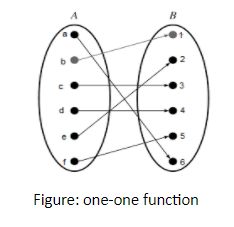
One mapping is selected at random from all mappings of the set \[S = \{ 1,2,3,....,n\} \] into itself. If the probability that mapping is one-one is $\dfrac{3}{{32}}$ then the value of n is ?
A) 2
B) 3
C) 4
D) None of these
Answer
480.3k+ views
Hint: A relation $\mathbb{R}:{\text{ A}} \to {\text{B}}$is defined as a function if every element of set A is mapped to one element of set B, i.e. , each object has only one image.

One-one function: When each element of set B is mapped to only one element of set A, i.e., each object in set A has a unique image in set B, then the function is called one-one function.
Let the number of elements in set A = n(A) = a
The number of elements in set B = n(B) = b
Necessary condition : ${\text{b }} \geqslant {\text{ a}}$ [ for one-one function $f:{\text{ A}} \to {\text{B}}$] …… (1)
Total number of functions $ = \mathop {\text{b}}\nolimits^{\text{a}} $ …… (2)
Number of one-one functions \[ = C({\text{b,a)}} \cdot {\text{a!}}\] $(\because 'C'{\text{is combination)}}$ …… (3)
Complete step by step solution:
The mapping of set \[S = \{ 1,2,3,....,n\} \] into itself can be drawn as,

Where the image of every element \[x\] in the domain, there exists an element \[f(x)\] in the range.
Step 1
Given set \[S = \{ 1,2,3,....,n\} \]
Step 2
Function $f:{\text{ S}} \to {\text{S}}$is defined. $(\because {\text{given}})$
Step 3
Number of elements in set S = n(S) = n.
Total number of functions \[f:{\text{ S}} \to {\text{S = }}\mathop {{\text{ }}n}\nolimits^n \] (from (2)) …… (4)
Step 4
Number of one-one functions $f:{\text{S}} \to {\text{S = }}C({\text{n,n)}}{\text{.n}}!$ (from (3))
$ = {\text{n!}}$ …… (5)
Step 5
Probability (selecting mapping is one-one) = \[\dfrac{{{\text{number of one - one functions }}f:{\text{S}} \to {\text{S }}\;}}{{{\text{total number of functions }}f:{\text{S}} \to {\text{S}}}} = \dfrac{3}{{32}}\]
$(\because {\text{given}})$
$ = \dfrac{{{\text{n!}}}}{{\mathop {\text{n}}\nolimits^{\text{n}} }} = \dfrac{3}{{32}}$ (from (4) and (5)) $\therefore $ n = 4 [by inspection]
Therefore, the correct option is (C), n=4.
Note:
Another classification of functions is onto functions. If for functions $f:{\text{A}} \to {\text{B}}$the co-domain set of B is also the range for the function, then the function is called an onto function.
The functions which are both one-one and onto are called bijective functions.

One-one function: When each element of set B is mapped to only one element of set A, i.e., each object in set A has a unique image in set B, then the function is called one-one function.
Let the number of elements in set A = n(A) = a
The number of elements in set B = n(B) = b
Necessary condition : ${\text{b }} \geqslant {\text{ a}}$ [ for one-one function $f:{\text{ A}} \to {\text{B}}$] …… (1)
Total number of functions $ = \mathop {\text{b}}\nolimits^{\text{a}} $ …… (2)
Number of one-one functions \[ = C({\text{b,a)}} \cdot {\text{a!}}\] $(\because 'C'{\text{is combination)}}$ …… (3)
Complete step by step solution:
The mapping of set \[S = \{ 1,2,3,....,n\} \] into itself can be drawn as,

Where the image of every element \[x\] in the domain, there exists an element \[f(x)\] in the range.
Step 1
Given set \[S = \{ 1,2,3,....,n\} \]
Step 2
Function $f:{\text{ S}} \to {\text{S}}$is defined. $(\because {\text{given}})$
Step 3
Number of elements in set S = n(S) = n.
Total number of functions \[f:{\text{ S}} \to {\text{S = }}\mathop {{\text{ }}n}\nolimits^n \] (from (2)) …… (4)
Step 4
Number of one-one functions $f:{\text{S}} \to {\text{S = }}C({\text{n,n)}}{\text{.n}}!$ (from (3))
$ = {\text{n!}}$ …… (5)
Step 5
Probability (selecting mapping is one-one) = \[\dfrac{{{\text{number of one - one functions }}f:{\text{S}} \to {\text{S }}\;}}{{{\text{total number of functions }}f:{\text{S}} \to {\text{S}}}} = \dfrac{3}{{32}}\]
$(\because {\text{given}})$
$ = \dfrac{{{\text{n!}}}}{{\mathop {\text{n}}\nolimits^{\text{n}} }} = \dfrac{3}{{32}}$ (from (4) and (5)) $\therefore $ n = 4 [by inspection]
Therefore, the correct option is (C), n=4.
Note:
Another classification of functions is onto functions. If for functions $f:{\text{A}} \to {\text{B}}$the co-domain set of B is also the range for the function, then the function is called an onto function.
The functions which are both one-one and onto are called bijective functions.
Recently Updated Pages
Master Class 11 English: Engaging Questions & Answers for Success

Master Class 11 Computer Science: Engaging Questions & Answers for Success

Master Class 11 Maths: Engaging Questions & Answers for Success

Master Class 11 Social Science: Engaging Questions & Answers for Success

Master Class 11 Economics: Engaging Questions & Answers for Success

Master Class 11 Business Studies: Engaging Questions & Answers for Success

Trending doubts
10 examples of friction in our daily life

What problem did Carter face when he reached the mummy class 11 english CBSE

Difference Between Prokaryotic Cells and Eukaryotic Cells

State and prove Bernoullis theorem class 11 physics CBSE

Proton was discovered by A Thomson B Rutherford C Chadwick class 11 chemistry CBSE

Petromyzon belongs to class A Osteichthyes B Chondrichthyes class 11 biology CBSE




